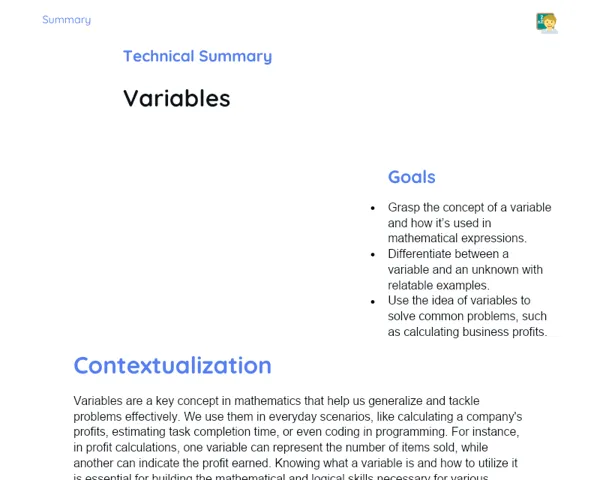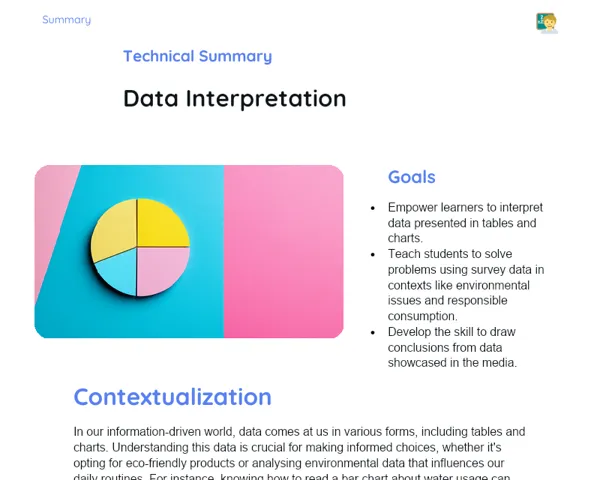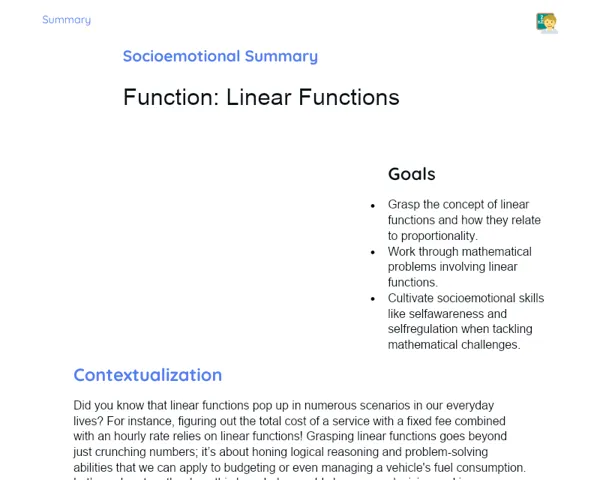Summary Tradisional | Spatial Geometry: Metric Relations of Prisms
Contextualization
Spatial Geometry is a branch of mathematics focused on understanding three-dimensional shapes, such as prisms, cylinders, and spheres. In this context, prisms are geometric solids characterised by two parallel and congruent bases, which are connected by lateral faces that are parallelograms. Grasping the properties and metric relations of prisms is essential for practical applications across various fields, including architecture, engineering, and product design.
In this lesson, we will concentrate on the metric relations of prisms, which entail calculating height, the sum of edges, and the distance between vertices not located on the same face. These relations play a crucial role in solving both practical and theoretical challenges. For instance, when determining the height of a prism in a construction project or calculating the distance between specific points in a 3D model. The application of these formulas and concepts will allow for accurate and efficient analysis of geometric structures, aiding in resolving complex problems.
To Remember!
Definition of a Prism
A prism is a geometric solid with two parallel and congruent bases, connected by lateral faces that are parallelograms. The bases can take the form of any polygon, while the lateral faces are always parallelograms. The height of the prism is the perpendicular distance between the two bases. Prisms can be classified as 'right' when the lateral edges are perpendicular to the bases, and 'oblique' when not.
Understanding the definition of a prism is critical for delineating its properties and the metric relations that can be computed. By identifying the bases, edges, and lateral faces, we can apply geometric formulas to ascertain measurements like height, area, and volume. A comprehensive understanding of a prism's elements is vital when solving practical problems in fields like architecture and engineering.
Additionally, accurately identifying a prism's elements enhances our ability to visualise in three dimensions and construct geometric models. This skill is particularly beneficial in disciplines that require extensive planning and analysis of physical structures. Precision in defining and recognising the components of a prism lays the foundation for correctly applying metric relations.
-
A prism is a geometric solid with two parallel and congruent bases.
-
The lateral faces are parallelograms.
-
Prisms can be classified as right or oblique.
Metric Relations in Prism
The metric relations in a prism involve calculating its height, the total length of edges, and overall surface area. The height of a prism is defined as the perpendicular distance between the bases. The sum of edges refers to the total length of all edges that form the prism. The total area encompasses the sum of the areas of all its faces, which include the bases and lateral faces.
To determine the height of a right prism, one can simply measure the perpendicular distance between the bases. In the case of oblique prisms, the height can be derived using trigonometric properties or other geometric methods. The sum of edges can be calculated by adding the lengths of edges from the bases alongside the lateral edges. The total area necessitates calculating the individual areas of the faces and summing them.
These metric relations are vital for resolving practical problems involving prisms, like assessing the length of materials needed to cover a prism (total area) or calculating the height for a building project. Correct application of these formulas enables precise and effective analysis of geometric structures.
-
Height is the perpendicular distance between the bases.
-
The sum of edges is the total length of all edges.
-
Total area is the sum of the areas of all the faces of the prism.
Distance Between Non-Adjacent Vertices
Calculating the distance between non-adjacent vertices of a prism can be executed using the Pythagorean Theorem in three dimensions. This calculation is crucial for figuring out the shortest distance between two points that aren't on the same face of the prism. In the context of a right prism, this distance can be simplified due to the perpendicular alignment of the lateral edges with the bases.
To compute this distance, one must identify a three-dimensional right triangle that connects the vertices. By applying the Pythagorean Theorem, we can determine the hypotenuse of this triangle, which reflects the required distance. This method can be extended to various prism types, as long as the dimensions of the edges are accessible.
Knowing how to calculate distances between non-adjacent vertices proves useful in a variety of practical scenarios, such as engineering and architectural projects where it's necessary to establish the distance between specific points of a structure. Understanding this concept is likewise important for tackling more complex challenges in three-dimensional geometry.
-
Uses the Pythagorean Theorem in three dimensions.
-
Essential for determining distances between points on different faces.
-
Applicable to a range of different types of prisms.
Practical Examples
Applying spatial geometry concepts in real-life examples is crucial for an in-depth understanding of the topic. Practical examples include calculating the height of a right prism, finding the distance between non-adjacent vertices, and summing the edges of various prism types. These examples help illustrate how formulas and theoretical concepts are implemented in real-world situations.
For example, to compute the height of a right prism with an equilateral triangle as its base, we can use formulas for lateral area in conjunction with the perimeter of the base. Another practical scenario is determining the distance between opposite vertices of a right prism with a square base, leveraging the Pythagorean Theorem in three dimensions. These exercises highlight the direct application of the concepts and formulas learned in class.
Engaging with practical problems also emphasises the necessity for precision and comprehension of a prism's elements. By addressing real-world problems, students can appreciate the relevance of spatial geometry across various professional fields and how the skills acquired can extend beyond the classroom.
-
Calculation of the height of right prisms.
-
Determination of distances between non-adjacent vertices.
-
Practical application of formulas and theoretical concepts.
Key Terms
-
Prism: geometric solid with two parallel and congruent bases and lateral faces that are parallelograms.
-
Height of the Prism: perpendicular distance between the bases of the prism.
-
Edges: line segments connecting the vertices of a prism.
-
Vertices: intersection points of the edges of a prism.
-
Lateral Faces: quadrilaterals connecting the bases of a prism.
-
Total Area: sum of the areas of all faces of a prism.
-
Pythagorean Theorem: method for calculating distances in right triangles, applicable in three dimensions.
-
Right Prisms: prisms whose lateral edges are perpendicular to the bases.
-
Oblique Prisms: prisms whose lateral edges are not perpendicular to the bases.
Important Conclusions
In this lesson, we explored the key metric relations of prisms, including how to calculate height, sum the edges, and find distances between non-adjacent vertices. We established that a prism is a three-dimensional geometric solid defined by two parallel and congruent bases connected by parallelogram lateral faces, and it was vital for us to accurately identify these components to effectively apply geometric formulas. We used the Pythagorean Theorem in three dimensions to ascertain distances between non-adjacent vertices, highlighting the concept's significance in real-world issues pertaining to engineering and architecture.
Our discussion around the practical application of theoretical concepts in real-life challenges demonstrated spatial geometry's relevance across numerous fields, from construction to the manufacturing of optical devices. Solving practical examples, like calculating prism heights and determining the sum of edges, illustrated how the theoretical concepts and formulas we've learned can be directly applied, reinforcing understanding through practice.
We emphasised the importance of studying the metric relations of prisms throughout the lesson, showcasing that the knowledge gained is crucial for tackling complex problems across various disciplines. We encourage students to further delve into the topic and apply their learnings in real scenarios, recognising how relevant spatial geometry is in honing their analytical and practical skills.
Study Tips
-
Review the definitions and properties of prisms, paying attention to the accurate identification of elements like bases, edges, and lateral faces.
-
Practice solving problems using the formulas discussed in class, such as calculating height, total area, and distances between vertices, to solidify understanding.
-
Investigate practical applications of spatial geometry concepts in fields like architecture and engineering, exploring real-world scenarios where these metric relations come into play.



